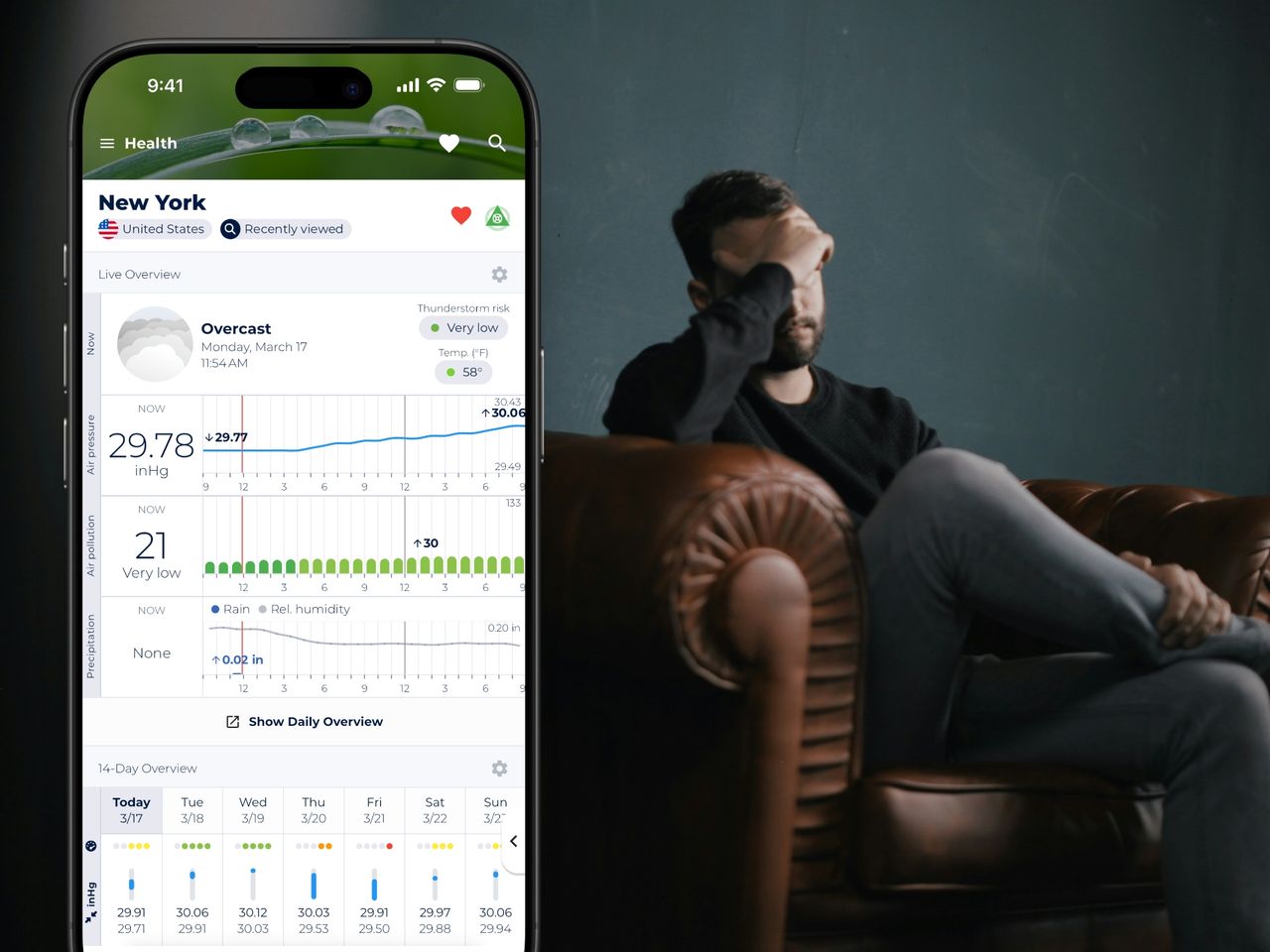
You wake up on a Tuesday morning feeling fine. But something tells you today’s different. The air feels heavy, and before your first symptom even appears, you know — a migraine is coming.
For millions of people living with migraines and sinus headaches, this scenario is all too familiar. Weather changes don’t just affect your plans; they can trigger debilitating headaches that derail your entire day. But what if you could see these triggers coming before the headache starts?
A migraine weather forecast does exactly that — helping you predict, prepare for, and potentially prevent weather-triggered headaches by tracking the atmospheric conditions that affect you most.
In this article:
Sonuby Weather’s Health Report provides 24-hour and 14-day barometric pressure forecasts, thunderstorm forecasts, and temperature tracking — everything you need to predict weather-triggered migraines and sinus headaches before they start.
If you’ve ever felt a migraine coming when storm clouds gather or experienced a sinus headache during a cold front, you’re not imagining things. Weather-related headaches are a documented medical phenomenon affecting an estimated 50-60% of migraine sufferers. [1]
The connection between weather and headaches is so strong that many people can predict weather changes based on how their head feels — a phenomenon that’s both a blessing and a curse. While this sensitivity makes you an unofficial weather forecaster, it also means atmospheric changes can significantly impact your quality of life.
Weather-triggered headaches fall into several categories:
Migraines: Severe, throbbing headaches often accompanied by nausea, light sensitivity, and visual disturbances. Weather changes can trigger migraine attacks in susceptible individuals.
Sinus Headaches: Pain and pressure around the sinuses (forehead, cheeks, and bridge of nose) caused by inflammation or pressure changes in the sinus cavities.
Tension Headaches: While less directly weather-related, these can be triggered by weather-induced stress, poor sleep during storms, or changes in daily routines due to weather.
The good news? Once you understand your specific weather triggers, you can use a migraine weather forecast to anticipate problem days and take preventive action. A reliable sinus headache forecast helps you prepare for atmospheric changes before symptoms begin.
Barometric pressure — also called atmospheric pressure or air pressure — is the weight of the air pressing down on Earth’s surface. This pressure isn’t constant; it fluctuates based on weather systems, with high-pressure systems bringing clear skies and low-pressure systems often bringing clouds and storms.
When barometric pressure drops rapidly, it creates an imbalance between the air pressure inside your sinuses and the outside atmosphere. This pressure differential can:
Think of your sinuses like small, air-filled rooms in your skull. When outside pressure drops suddenly — like before a storm — the pressure inside these rooms is now relatively higher, causing expansion and discomfort.
Research shows that rapid changes are more problematic than absolute pressure levels. Studies have found that barometric pressure drops increase the risk of headaches in the days following the change, with lower pressure systems being particularly problematic for headache sufferers. [3]
This is why a migraine forecast today is so valuable — you need to track pressure trends over time, not just a single daily number.
A day that looks “fine” on a standard weather app might include pressure changes that spell trouble for headache sufferers.
While barometric pressure changes are the most common trigger, several other weather factors can cause or contribute to migraines and sinus headaches:
Rapid temperature changes — especially drops of 5°C (9°F) or more within 24 hours — can trigger migraines. Cold fronts are particularly problematic because they combine temperature drops with pressure changes and increased wind.
High humidity (above 70%) creates additional challenges:
Low humidity isn’t ideal either, as dry air can irritate nasal passages and sinuses.
Approaching thunderstorms create a perfect storm (pun intended) of headache triggers:
Many migraine sufferers report that their worst headaches occur 1-2 days before major storms — before the rain even starts.
While not a traditional “weather” factor, intense sunlight, snow glare, and sun reflection off water can trigger light-sensitive migraines. This is why sunny days aren’t always headache-free days.
If you’ve tried using a regular weather app to track your headache triggers, you’ve probably noticed they don’t quite work. Here’s why:
Limited Pressure Data: Most weather apps show only the current barometric pressure, maybe with a single daily value. They don’t show you the hourly changes that actually trigger headaches.
Not Designed for Health: Weather apps prioritize rain forecasts and temperatures — useful for planning outfits, but not for managing chronic pain conditions.
Missing Context: Even when pressure data is available, it’s usually buried in menus and presented without the context headache sufferers need.
What you need is a specialized migraine weather forecast that puts pressure tracking front and center, shows you trends over multiple days, and helps you plan around trigger periods. Whether you need a sinus forecast for planning your day or want to check headache weather today, specialized health-focused apps provide the detailed data that standard weather apps simply can’t match.
This is where Sonuby Weather changes everything for people living with weather-triggered headaches.
Sonuby’s Health Report was designed specifically with migraine and sinus headache sufferers in mind. It provides all the atmospheric data you need to predict trigger days — displayed in clear, interactive graphs that are actually easy to understand.
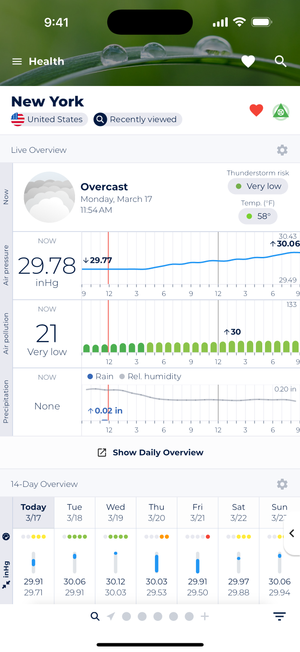
The Live Overview forecast available in the Health report shows a barometric pressure graph for the upcoming hours.
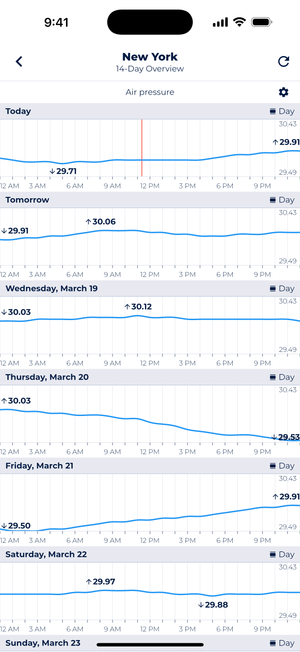
Barometric pressure graphs are available throughout the app, in this case as part of the 14-Day Overview.
Sonuby’s Live Overview displays a 24-hour barometric pressure graph right at the top of your screen. You can see at a glance:
This means when you check headache weather today, you get the full picture — not just a single number, but the entire pressure story for your day. Whether you’re monitoring your migraine forecast today or tracking longer-term patterns, the Live Overview gives you the insights you need.
Need to schedule important meetings or plan activities? Sonuby’s 14-Day Overview shows you barometric pressure patterns up to two weeks in advance.
You can:
The 14-Day Overview includes daily minimum and maximum pressure readings, so you can see not just what the pressure will be, but how much it will fluctuate each day — critical information for managing weather-sensitive conditions.
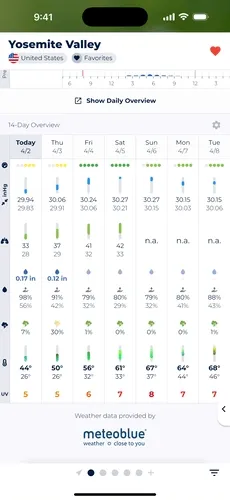
Tap on a day to see detailed hourly forecasts.
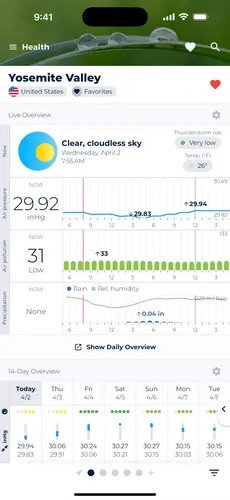
Daily pressure forecasts & more with Daily Overview.
The Health Report doesn’t just track pressure — it monitors all weather factors that affect headache sufferers:
Thunderstorm Risk: Get advance warning of approaching storms, which combine multiple headache triggers. Plan accordingly with early medication or schedule flexibility.
Temperature Tracking: See hourly temperature changes to identify cold fronts and rapid temperature drops that might trigger migraines.
Air Quality Data: Monitor air pollution levels, which can worsen sinus issues and trigger headaches in sensitive individuals.
UV Index: Track sun intensity for those whose migraines are triggered by bright light.
All of this data is presented in clear, easy-to-read graphs specifically designed for daily health management — not buried in weather forecast details. Your personalized sinus headache forecast combines all these factors to give you the complete picture.
Everyone’s triggers are unique. Sonuby lets you customize exactly what you see:
This personalization means your migraine weather forecast shows exactly what matters to you — no more, no less.
Sonuby users with weather-sensitive conditions report several key benefits:
Proactive Medication Timing: Instead of waiting for headache symptoms to start, take preventive medication when you see pressure drops approaching. Early intervention is often more effective.
Better Daily Planning: Schedule important meetings, workouts, or social activities on low-risk days. Keep demanding tasks flexible when trigger conditions are forecast.
Reduced Anxiety: Knowing what’s coming removes the uncertainty. You’re prepared rather than surprised by sudden weather-triggered headaches.
Pattern Recognition: Over time, you’ll identify your specific triggers and thresholds. Maybe you’re more sensitive to pressure drops in winter, or certain temperature ranges affect you more. This data is invaluable for working with your doctor.
Travel Planning: Check pressure forecasts for your destination before traveling. Pack appropriate medication and know what to expect. A quick check of your migraine forecast today before a trip can help you plan accordingly.
Sonuby Weather is free to download and provides global coverage. Whether you’re tracking your migraine forecast today in New York, monitoring sinus pressure in London, or checking headache weather in Tokyo, Sonuby has you covered.
The app is available on both iOS and Android, with all core health tracking features available in the free version. Premium features add additional customization options, but the essential barometric pressure tracking you need is always free. Get your personalized sinus forecast and start managing weather-triggered headaches more effectively.
Living with migraines or chronic sinus headaches means weather isn’t just small talk — it’s a health factor you need to monitor. A migraine weather forecast transforms you from a passive victim of atmospheric changes into someone who can predict, prepare for, and often prevent weather-triggered headaches.
With Sonuby’s detailed barometric pressure tracking, 14-day forecasts, and health-focused interface, you finally have the tool you need to manage weather-sensitive conditions effectively. Check your sinus forecast, monitor pressure changes, and plan your days with confidence.
Your head might still predict storms — but now you’ll see them coming before your headache does.
Download Sonuby Weather today and start tracking your migraine forecast for free.
A migraine weather forecast tracks atmospheric conditions like barometric pressure, temperature, and humidity that can trigger migraines and headaches. Unlike standard weather apps, it focuses specifically on the variables that affect headache sufferers, helping you predict trigger days before symptoms start.
Yes. Scientific studies show that changes in barometric pressure, temperature fluctuations, humidity levels, and approaching storms can trigger migraines and sinus headaches. Rapid pressure drops are particularly problematic, as they affect sinus cavities and can trigger migraine pathways in sensitive individuals.
You need a weather app that tracks barometric pressure changes throughout the day. Sonuby's Health Report provides hourly barometric pressure graphs, 14-day forecasts, and thunderstorm risk forecasts — all the data migraine sufferers need to plan their day proactively.
It's not just the pressure level — it's the rate of change. Rapid drops in barometric pressure (typically 5+ hPa or 0.15+ inHg within a few hours) are the most common trigger. Some people are sensitive to low pressure systems (below 30 inHg/1016 hPa), while others react to rapid increases.
Yes. Sinus headache forecasts track the same atmospheric conditions as migraine forecasts—barometric pressure changes, humidity levels, and temperature fluctuations. These factors directly affect sinus cavity pressure and can trigger sinus headaches. Sonuby provides detailed pressure tracking for sinus headache sufferers.
Absolutely. Sonuby Weather provides real-time and hourly migraine weather forecasts, showing you current barometric pressure and predicting changes throughout the day. The Live Overview displays a 24-hour pressure graph so you can see exactly when triggers might occur today.
Beyond barometric pressure, common triggers include: rapid temperature changes (especially drops), high humidity (above 70%), approaching thunderstorms, strong winds, and extremely bright sunlight. Each person's triggers are unique, which is why tracking patterns with detailed weather data is so valuable.
By checking your migraine weather forecast daily, you can: take preventive medication before trigger periods, avoid strenuous activities on high-risk days, plan indoor alternatives when storms approach, stay hydrated during pressure changes, and maintain consistent sleep schedules during weather transitions.
Sonuby Weather's Health Report is specifically designed for migraine and sinus headache sufferers. It provides 24-hour and 14-day barometric pressure graphs, thunderstorm forecasts, temperature tracking, and customizable forecasts—all the tools you need to predict and manage weather-triggered headaches. Available free on iOS and Android.
Resources:
[1] Prince, P. B., et al. (2004). The effect of weather on headache. Headache: The Journal of Head and Face Pain, 44(6), 596-602. https://doi.org/10.1111/j.1526-4610.2004.446008.x
[2] Kesserwani, H. (2021). Migraine Triggers: An Overview of the Pharmacology, Biochemistry, Atmospherics, and Their Effects on Neural Networks. Cureus, 13(4), e14243. https://doi.org/10.7759/cureus.14243
[3] Mukamal, K. J., et al. (2009). Weather and air pollution as triggers of severe headaches. Neurology, 72(10), 922-927. https://doi.org/10.1212/01.wnl.0000344152.56020.94